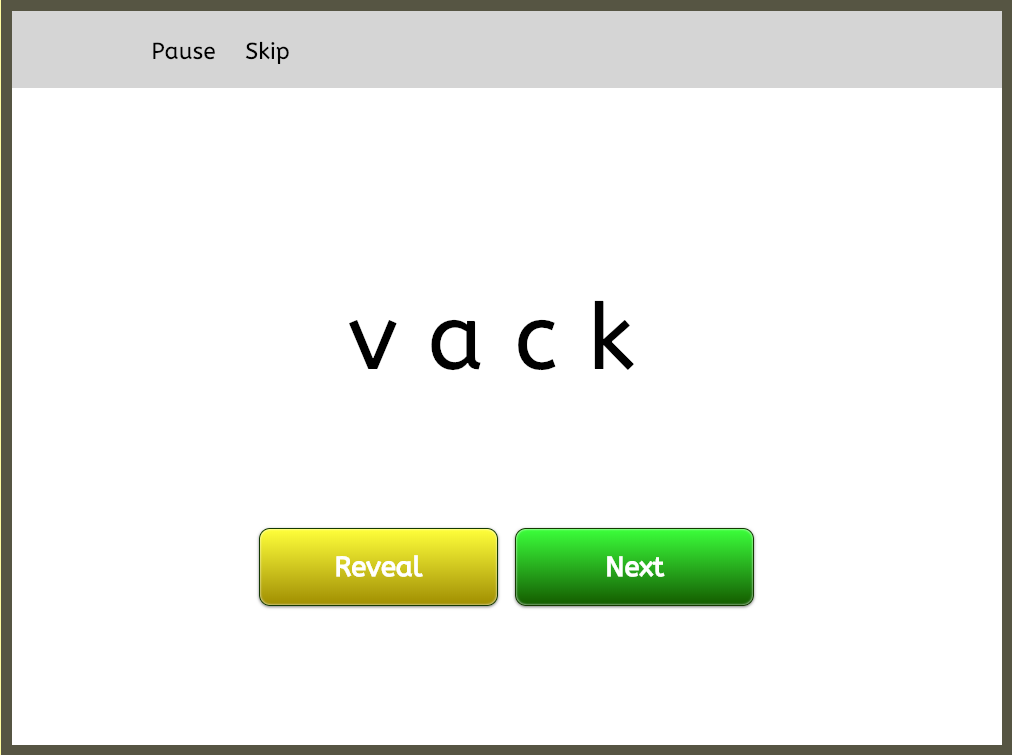Article Library
How to Help a Child Blend Sounds Into Words
by Lydia Cockburn | 23 April 2019
If you’ve seen these issues, it can often signal that your child has a problem blending sounds. Blending is a crucial skill for your child to master when they are learning to read.
The good news is that we find it is easily fixed with the right little exercise. Below I outline the reasons why certain children face this challenge, and explain how you can help your child overcome it. But first, let me clarify what we mean when we talk about blending.

Nonsense words are a great way to practice blending (as seen in this screenshot from the Easyread intervention)
What we mean by “blending”
When you’re first learning to read, you need to break words down into their sounds, then blend the sounds together to get the word. For example, faced with the written word “cat”, you sound out /k/, /a/, /t/, and then blend the sounds together to get “cat”.
Blending can often be harder in words containing more unusual groups of sounds, such as the first cluster of sounds in “sprint”. As a result, the term “consonant blend” is often used to describe these consonant clusters like gr-, pl-, and st-.
For some children, it’s not just these more unusual sequences of sounds that are hard to blend together; any word can potentially be difficult. We’re using the term “blending” in this broader sense of mentally sticking sounds together to work out the word.
Why blending is essential
A blending ability is crucial because it forms part of the decoding process, and decoding is what learning to read is all about. Some people will dispute that, but we work with a stream of struggling readers and we get each of them reading confidently by switching them from whole word sight reading and guessing to decoding and blending.
If a child struggles with blending, they will not be able to carry out this process. That means that even though they have successfully decoded what sounds are in the word, they will probably end up guessing it. That is why you sometimes hear a child decode the sounds in a word and then say some completely different word!
Why blending is hard for some children
We’ve established that a child will need to blend in order to learn how to read. We’ll get to the solutions in a moment, but in order to apply those well, it’s best to understand why the child is struggling first.
There are two main things that can make blending difficult for some children: auditory processing weakness and short term memory weakness.
1. Auditory Processing Weakness (APW) – children who struggle to blend letter sounds, even in short words
The Key Symptom
The main indicator of some auditory processing weakness is that all words, long and short, tend to be hard to decode and blend. It is always a bit of a struggle.
What APW means
Some children have a certain level of weakness or developmental delay in their auditory processing function. Their hearing may be perfect, but there can still be interruption in how the brain processes the auditory information passed to it from the ear. In a reading environment this is also often referred to a phonological processing weakness.
Auditory or phonological processing weakness can result from something as small as ear infections or glue ear when the child is very young. If this occurs during the critical period when the child is mentally segmenting speech into its various sounds (referred to as phonemes), it can remain hard for them to discriminate one sound from another later in childhood, and also to understand the relationship between the whole word and the sounds comprising it. Often, but not always, these children will have some speech delay too.
In some cases, there is no such history of hearing loss, speech delay or diagnosed auditory processing difficulties, but there is clearly some level of weakness with auditory processing evidenced by the child’s difficulty with phonological tasks such as rhyming and blending.
The good news is that auditory processing usually can be strengthened and blending ability improved, with the right kind of practice.
How to help: a simple exercise
At Easyread, we often recommend that parents try a short, simple exercise designed to help children overcome blending issues. If your child is struggling to blend phonemes into words, we recommend you try this short game with your child:
Ask your child to think of 5 different words each day to break apart. Then, ask your child to put the sounds back together again into the word. For instance, if they choose the word grass, you will want them to break the word down into /g/, /r/, /a/, and /s/. They should do this exercise out loud, and there is no need to write the words down.
Once your child has completed this task, ask them to put the sounds back together again to reform the word.
Try this short, simple exercise of breaking five words down and then re-forming them every day for five days. In less than a week, this simple exercise will lead to real improvements in how your child blends the sounds in words. We have never known it to fail!
2. Short Term Auditory Memory Weakness – children who struggle to work out long words
The Key Symptom
With a short term auditory memory weakness, you will see a child manage to decode and blend short words, but struggle much more with long words.
What it means
These children have some weakness with their working (short-term) memory, and they therefore struggle to retain a large number of sounds for long enough to blend them together. By the time they have worked out all the sounds in the word, they have forgotten the ones at the beginning!
How to help
The best way to deal with this is to offer your child plenty of help with the long words. Cover up parts of the word so that they are decoding smaller chunks and trying to piece those together.
Once the decoding becomes automatic, it ceases to be a problem because they no longer have to consciously retain all the separate sounds. In the meantime, just support your child to make sure they are decoding everything they can. With time, the decoding will become easier and more automatic. It can just take a bit longer to get to that happy situation.
Our trainertext tends to help with the practice a lot and reduce the cognitive load for the decoding, which then makes the blending easier. We have also seen the work we do with the children actually improves their auditory short term memory too. In both ways you will get to confident, fluent reading a lot quicker with TVP.
 Lydia Cockburn is an Easyread System Manager and frequent contributor at Helping Children to Read. When not coaching students and families in overcoming barriers to reading, she can often be found playing music or football.
Lydia Cockburn is an Easyread System Manager and frequent contributor at Helping Children to Read. When not coaching students and families in overcoming barriers to reading, she can often be found playing music or football.
